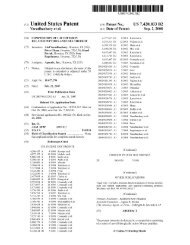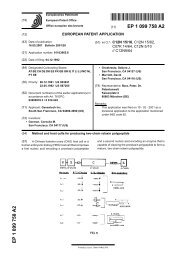EP 1 211 261 A2
EP 1 211 261 A2
EP 1 211 261 A2
Create successful ePaper yourself
Turn your PDF publications into a flip-book with our unique Google optimized e-Paper software.
<strong>EP</strong> 1 <strong>211</strong> <strong>261</strong> <strong>A2</strong>5101520253035404550by reducing the potential for forming pockets of deoxy-Hb containing high concentrations of glutaraldehyde. Generallyuniform mixing of glutaraldehyde and deoxy-Hb reduced the formation of high molecular weight poly(Hb) (having amolecular weight above 500,000 Daltons) and also permitted faster mixing of glutaraldehyde and deoxy-Hb duringpolymerization.[0196] In addition, significant Hb intramolecular cross-linking resulted during Hb polymerization as an effect of thepresence of N-acetyl cysteine upon the polymerization of Hb.[0197] After polymerization, the temperature of the poly(Hb) solution in the polymerization reactor was reduced to atemperature between about 15°C to about 25°C.[0198] The poly(Hb) solution was then concentrated by recirculating the poly(Hb) solution through the ultrafilter untilthe concentration of the poly(Hb) was increased to about 85 g/l. A suitable ultrafilter is a 30,000 Dalton filter (e.g.,Millipore Helicon, Cat # CDUF050LT).[0199] Subsequently, the poly(Hb) solution was then mixed with 66.75 g sodium borohydride, and then again recirculatedthrough the static mixer. Specifically, for every nine liters of poly(Hb) solution, one liter of 0.25 M sodium borohydridesolution was added at a rate of 0.1 to 0.12 lpm.[0200] Prior to adding the sodium borohydride to the poly(Hb) solution, the pH of the poly(Hb) solution was basifiedby adjusting pH to a pH of about 10 to preserve the sodium borohydride and to prevent hydrogen gas formation. ThepH of the poly(Hb) solution was adjusted by diafiltering the poly(Hb) solution with approximately 215 l of depyrogenated,deoxygenated 12 mM sodium borate buffer, having a pH of about 10.4 to about 10.6. The poly(Hb) solution was diafilteredby recirculating the poly(Hb) solution from the polymerization reactor through the 30 kD ultrafilter. The sodiumborate buffer was added to the poly(Hb) solution at a rate approximately equivalent to the rate of fluid loss across theultrafilter from diafiltration. Diafiltration continued until the volume of fluid lost across the ultrafilter from diafiltration wasabout three times the initial volume of the poly(Hb) solution in the polymerization reactor.[0201] Following pH adjustment, sodium borohydride solution was added to the polymerization reactor to reduceimine bonds in the poly(Hb) solution to ketimine bonds and to form stable poly(Hb) in solution. During the sodiumborohydride addition, the poly(Hb) solution in the polymerization reactor was continuously recirculated through thestatic mixer and the 0.05 µm polypropylene microfilter phase transfer membrane to remove dissolved oxygen andhydrogen. Flow through a static mixer also provided turbulent sodium borohydride flow conditions that rapidly andeffectively mixed sodium borohydride with the poly(Hb) solution. The flow rates of poly(Hb) solution and nitrogen gasthrough the 0.05 µm phase transfer membrane were between about 2.0 to 4.0 lpm and about 12 to 18 lpm, respectively.After completion of the sodium borohydride addition, reduction continued in the polymerization reactor while an agitatorcontained therein rotated at approximately 75 rotations per minute.[0202] Approximately one hour after the sodium borohydride addition, the stable poly(Hb) solution was recirculatedfrom the polymerization reactor through the 30,000 Dalton ultrafilter until the stable poly(Hb) solution concentrationwas 110 g/l. Following concentration, the pH and electrolytes of the stable poly(Hb) solution were restored to physiologiclevels to form a stable polymerized Hb blood-substitute, by diafiltering the stable poly(Hb) solution, through the 30,000Dalton ultrafilter, with a filtered, deoxygenated, low pH buffer containing 27 mM sodium lactate, 12 mM NAC, 115 mMNaCl, 4 mM KCl, and 1.36 mM CaCl 2 in WFI, (pH 5.0). Diafiltration continued until the volume of fluid lost throughdiafiltration across the ultrafilter was about 6 times the pre-diafiltration volume of the concentrated Hb product.[0203] After the pH and electrolytes were restored to physiologic levels, the stable polymerized Hb blood-substitutewas then diluted to a concentration of 5.0 g/dl by adding the filtered, deoxygenated low pH buffer to polymerizationreactor. The diluted blood-substitute was then diafiltered by recirculating from the polymerization reactor through thestatic mixer and a 100,000 Dalton purification filter against a filtered deoxygenated buffer containing 27 mM sodiumlactate, 12 mM NAC, 115 mM NaCl, 4 mM KCl, and 1.36 mM CaCl 2 in WFI, (pH 7.8). Diafiltration continued until theblood-substitute contained less than or equal to about l0% modified tetrameric and unmodified tetrameric species byGPC when run under dissociating conditions.[0204] The purification filter was run under conditions of low transmembrane pressure with a restricted permeateline. Following removal of substantial amounts of modified tetrameric Hb and unmodified tetrameric Hb, recirculationof the blood-substitute continued through the 30,000 Dalton ultrafilter until the concentration of the blood-substitutewas about 130 g/l.[0205] The stable blood-substitute was then stored in a suitable container having a low oxygen environment and alow oxygen in-leakage.Example 255Hemoglobin Blood-Substitute Storage[0206] The hemoglobin blood-substitute, as prepared in Example 1, packaged in a 600 mL Stericon package, wasoverwrapped in a foil laminate package (KAPAK 50303, referred below as "foil"), Cryvac BYV200 or Cryovac P640B20




